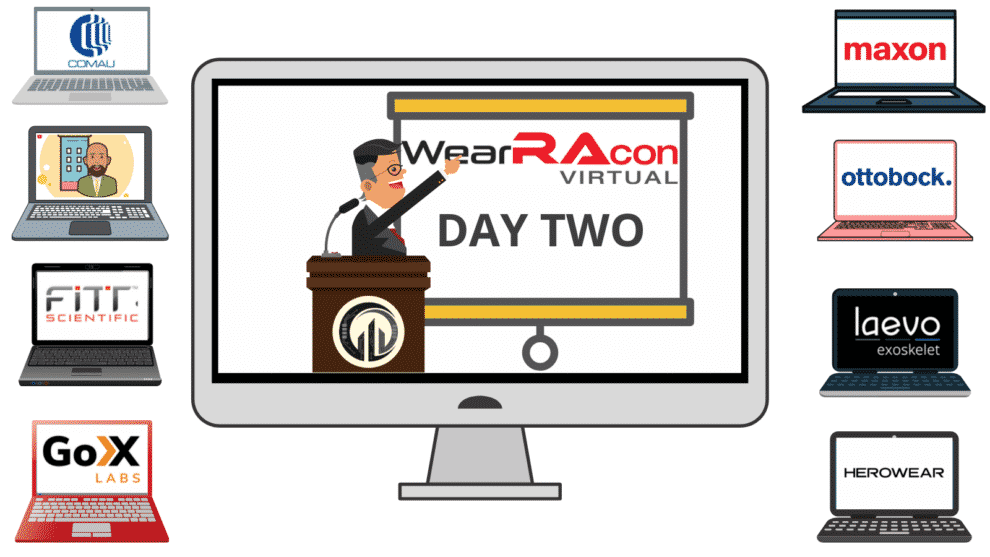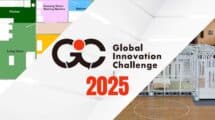WearRAcon 20 Virtual, organized by the Wearable Robotics Association completed its second and final day with another whirlwind of presentations on topics related to exoskeleton systems and powered prosthetics. This was the first time in its five year run that WearRAcon has been held digitally. This year, the conference was two days long compared to its usual two and a half days.
The first session of WearRAcon 20 Day Two started with what was the hottest topic of the hour: the work to create a quality label for back and shoulder support exoskeletons, an initiative by WearRA, Fraunhofer IPA and the National University of Singapore (NSU), which was announced at the opening of the conference during day one.
Dr. Urs Schneider, representing Fraunhofer IPA (FhG IPA) outlined that industrial exoskeletons are a promising technology and standardization efforts have started worldwide. In his presentation, he took the time to highlight the work by ASTM International, ISO, DIN, DGUV, EUROBENCH, DGAUM, Exo@work, and NRIS (guideline for the acquisition and integration of exoskeletons in companies). While standards are definitely being made and are coming, Dr. Urs Schneider suggested an alternative during his presentation: for developers and users to come together and agree as an industry on the “good qualities” that an exoskeleton should have.
The task at hand would be the short-term establishment of a “quality label” based on testing protocols issued by a consensus of consumers and developers. The goal is to create a quality label that can distinguish devices that are approved by the industry and those that are not: specifically, knockoff wearables and those with obvious design flaws (recall the spring arm protruding forward from a belt attached at the waist which created a moment at the spine but the evaluators still deemed as an “exoskeleton”). The presenter emphasized that this is not meant to be a standard but instead a joint protocol that helps customers not familiar with exoskeleton technology make educated decisions and have proof that they are purchasing a quality product.
At a very minimum, Dr. Urs Schneider sees this move as a protective mechanism against copycat exoskeletons (a topic that that is indeed being discussed more often than ever before). According to the presentation, there is already positive feedback on this initiative from ITURRI. The proposed timeline is to spend 2020 gathering input and create a complete image of how this will be done by the next WearRAcon in 2021.

Switching gears from physically evaluating exoskeletons to digitally designing exos was Dr. Pavel Galibarov from AnyBody Technology. As early as 2015 it was possible to perform Modeling a Human in an Exoskeleton: AnyBody Simulation. In the last five years, the company has not been idle and the presentation at WearRAcon 20 Virtual Day Two showed the capability to add external objects in addition to the simulated exoskeleton and user. The example presented was of a car plant employee interacting with their workstation, then with an overhead moving vehicle, followed by the simulated user returning back to their station. AnyBody Technology can begin to create full workspace simulations with exoskeletons and its interaction with both the user and the environment.
The above was only a fraction of the presentation by AnyBody Technology. The majority of the time was dedicated to a study of the Paexo shoulder support exoskeleton by Ottobock. Note that the presenters do not envision simulated testing to replace physical testing, only to complement it.
The keynote speaker for the second day of WearRAcon 20 was Michael Goldfarb, Ph.D., Professor, Vanderbilt University and Creator of the Indego Exoskeleton. His presentation was focused on working in the space between passive and active wearable robotics: a semi-powered approach. The objective is to look for small amounts of power that can provide a big payback.
Dr. Goldfarb’s keynote was followed by the classical WearRA Innovation Challenge which transpired much as it always had. There were some very strong presentations that mainly focused on medium and long term applications of wearable robotics which we will cover in a separate article.
The remainder of the day featured no less than ten additional presentations on all manner of subjects related to wearable robotics, exoskeletons, exosuits, powered clothing, dermoskeletons, etc… Some examples include:
As part of his presentation, Matt Giffhorn, Shirley Ryan AbilityLab, presented data on using gait assist exoskeletons not to assist the user but resist movement on purpose. His data showed some promising results.
Dr. Gail Forrest from the Kessler Foundation used a portion of her time to present more information on integrating functional electrical muscle stimulation together with gait assist exoskeletons. The initial data suggests that the gains made during physical rehabilitation are retained for longer after the patient returns home. The subject of being able to take rehabilitation exoskeletons and use them in the home setting was brought up on more than one occasion.

Matt Marino from HeroWear shared some lessons learned on integrating exoskeletons in the workplace in terms of don/doff time, ability to go through tight spaces, etc… One example that was particularly memorable was that in a lab setting one does not consider the additional risk of snagging from wearing an exoskeleton to be significant. That assessment, however, depends on the context in which the exoskeleton is being used. If the user is on an airplane preparing to parachute cargo pallets, having the exoskeleton snag on any of the pallets as they are sliding out of the airplane would suddenly be of very high concern. In addition to good design that takes into account the real-world environments that exos can find themselves in we also require education. Great technology that sits in a corner and collects dust doesn’t do any good to anyone.
The WearRAcon series will continue as a joint meeting with the International Symposium on Wearable Robotics (WeRob2020) and WearRAcon Europe, scheduled for Oct 13-16, 2020 in Vigo, Spain: link
In his closing remarks, WearRA’s Director of Operations Dr. Bruce Floersheim highlighted ErgoX planned for Oct 5, 2020, in Chicago and the work being done by ASTM F48.
WearRAcon 21 is intended to be back in sunny Arizona next March!
See more of our coverage: WearRAcon 20 Virtual Day One Report








Add Comment